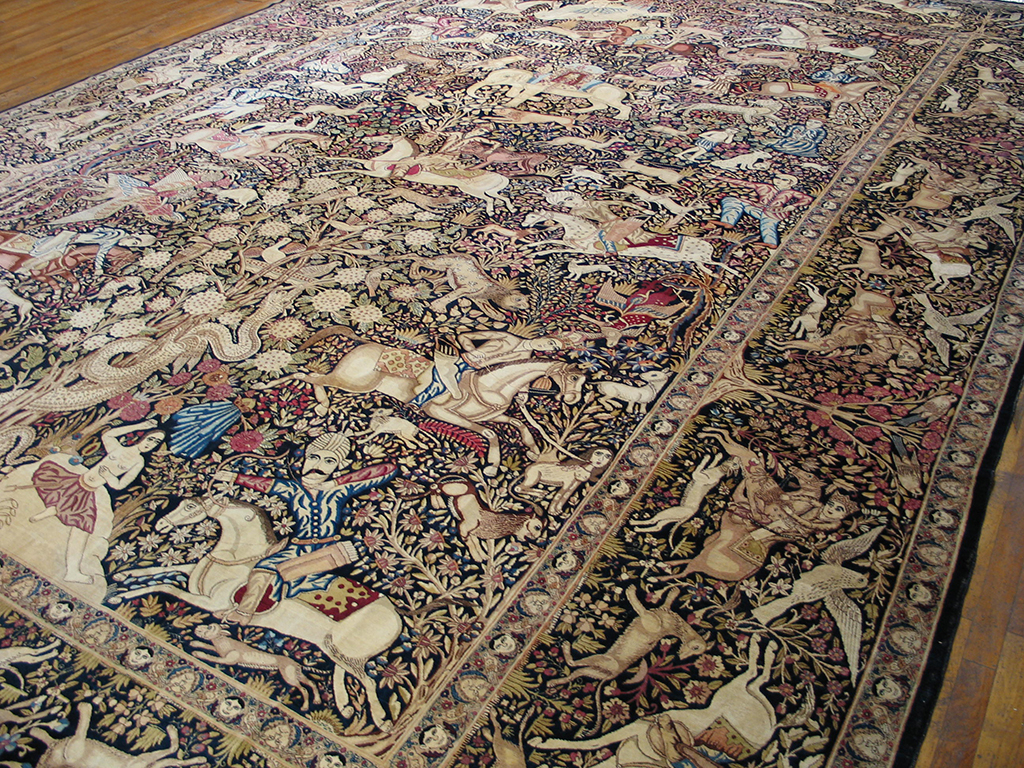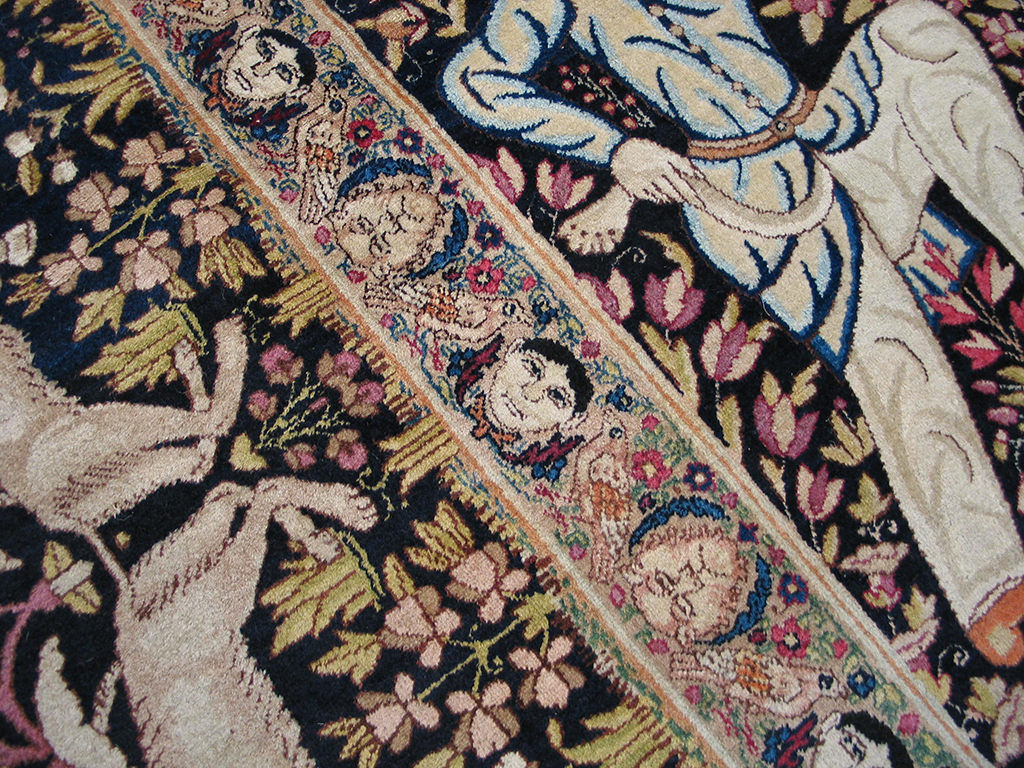#20799
Kerman, Kerman Province, S.E. Persia
13’ x 18’9” (3.96 x 5.72m)
Circa 1900
Provenance: workshop of Master Weaver (Oustad Ali Kermani)
Structure
Structure: typical Kerman triple wefted weave.
Warp: cotton, beige, natural, Z-6-S-3-Z, machine spun cable.
Weft: cotton, beige, natural, Z-4-S handspun (?); 3 shoots alternating: 1st and 3rd wavy; 2nd straight.
Pile: wool, Z-2; Persian (asymmetric) knots open left; 90º alternate warps depressed; horizental 16 x vertical 16-18 = 256-298/inch sq.
Sides: 1 cord of cotton warps, wrapped in dark blue wool.
Ends: 3/8” balanced beige cotton plainweave, then a fringe of warps bunched in 16’s and knotted.
Description and Iconography
This carpet is basically a royal hunt with a variety of hunters, animals, background flora, and small vignettes from other Persian tales. The individual figures (and groups) are taken directly or otherwise from miniature paintings. Both the field and border have the same style of hunter on horseback and are unified by the dark blue ground.
Among the traditional figures are:
- The hunter attacked by a lion – here the designer has omitted the dagger wielded by the royal figure as the beast attacks;
- the hunter with a sword attacking a lion;
- a hunter, in this case with a Shah ‘Abbas style mustache, with a bow;
- hunters lassoing wild goats – one is clearly a shepherd, one a more noble figure;
- hunter spearing a (small) leopard;
- hunters with daggers attacked by lions;
Of particular note are the variegated saddle-covers of the riders.
Other figurines are taken from Persian miniatures as well:
- The figure, naked to the waist, with crown and sumptuous robes on a tree is probably Shirin bathing in a pool from Khosrow and Shirin by Nizami;
- the semi-clothed male figure confronted by a female, probably represents Majnun and Laila from the tale of the same title, also by Nizami;
- the regal woman in a howdah on an elephant may be Shirin or Laila or perhaps is from another tale. The details of the howdah indicate that it was closely copied from a painted original.
There is a wide variety in male headgear: crowns with and without high internal caps; stick turbans, flat caps, felt hats.
The figure of Bahram Gur may be represented by a lion hunter or may simply be an inspiration for these generic hunters.
The hunters wield:
- scimitars (shamshirs)
- bows and arrows
- maces
- lassoes
- curved daggers
The fauna is widely varied and includes:
- lions
- tiger
- wild horses
- domesticated horses
- boars
- leopards in two color ways
- cheetahs
- antelope
- wild goats
- harpis or sphinxes with human heads and breasts
- hunting hawks
- Indian elephant
- various hunting dogs
- monkeys
- bulbuls
- doves
- two types of Simurgh
- other birds
- reindeer (spotted)
- rabbits
- wolf
- tapir (?)
- dragon
The floras are equally diverse, but not so identifiable, though probably include prunes, flowering peach daisies, roses, etc. The background is in a millefleurs style.
Odd motifs include the severed hand in the jaws of the wolf, and the harpy head with the cheetah. Animals attack other animals. In particular, the huge scaly dragon ascending toward the bird’s nest: this is a symbol of evil attacking the innocent. Another is the small Simurgh devouring a dove. There are no combats of purely terrestrial animals.
There is no perspective and there is a naive juxtaposition of figures and decorative elements. The color palette, as is common in the best Kermans, is extremely wide and there are probably 15 or more colors.

























Attribution and Dating
A possible attribution of the design is to Zeman Khan of Kerman. Compare his Interpretation in wool of the 16th century Kashan silk hunting carpet in Vienna from 1922 (Edwards, A. The Persian Carpet, London 1953, ill. 214, p. 227) – in which some of the figures are identical, although, as in the original, all wear the mid-century stick turbans. Also close are the renderings of the animals, especially the shading of the horses. Note particularly the analogous spotted horse in each carpet. The colorful saddle covers of the riders are all extremely similar.
The use of classical Persian motifs from carpets and paintings was particularly popular in Kerman in the 1900’s. Even in the minor borders – an alternation of div (demon) heads and female faces – reference to earlier prototypes is made. In some 16th century carpets demon faces are a border motif.
Edwards dates a pictorial unidirectional piece with a similar millefleurs ground to circa 1890. The millefleurs ground of our piece and the 1900s carpet are virtually identical. Thus, an attribution of Zaman Khan and a date in the early 1900’s are most likely.
To view this rug on our website, click here.

